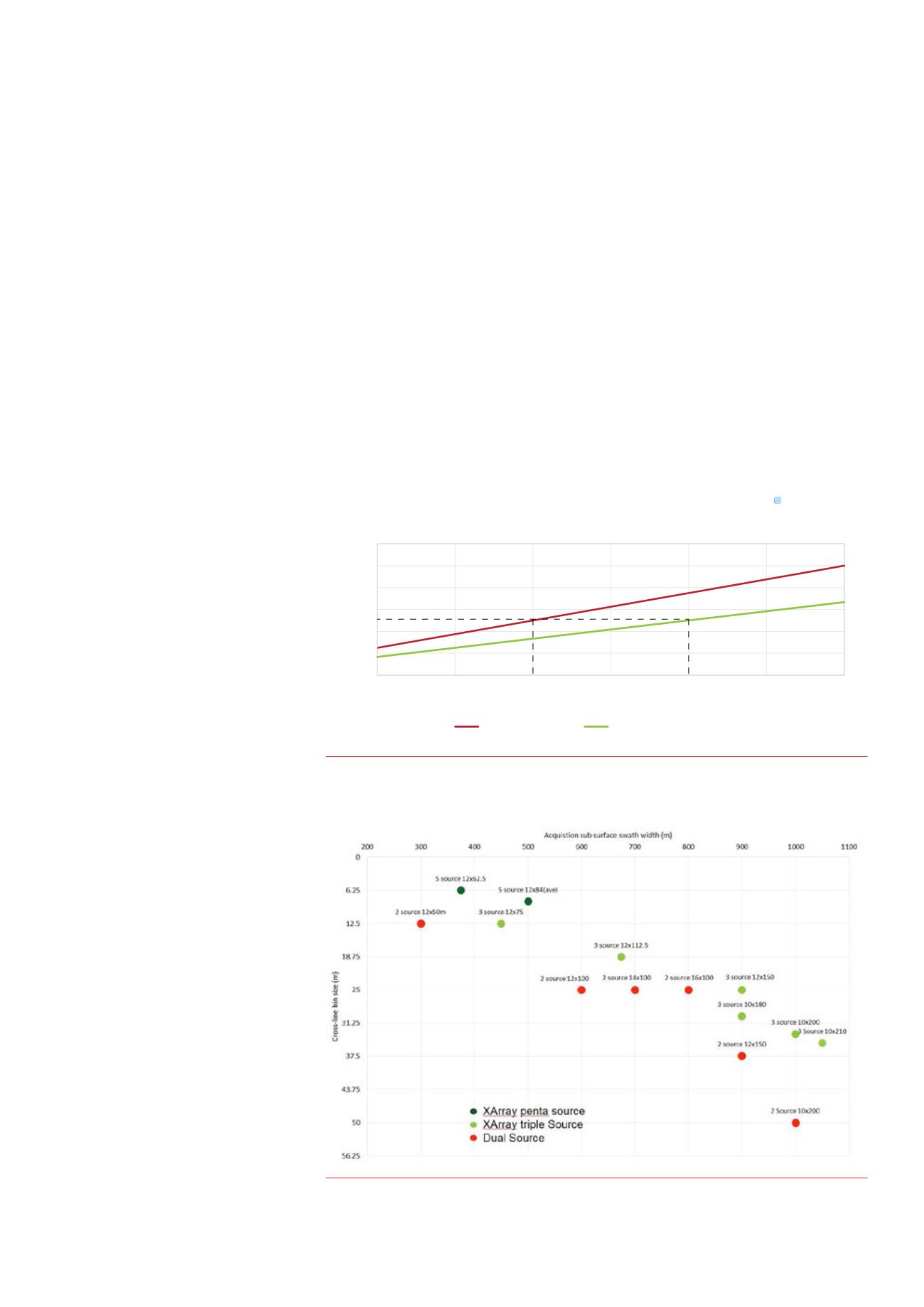
June 2016
Oilfield Technology
|
19
sources can still retain the benefits of inline shot density,
while reducing the cross-line CMP sampling achieved per unit
of streamer separation. This can prove beneficial to the large
majority of surveys and is the essence of the XArray offering.
The cross-line CMP sampling interval achievable with
a given source and streamer configuration is calculated by
dividing the streamer separation by two times the number of
sources. Single or dual sources were the only geophysically
viable option available for use in narrow azimuth acquisition
up until XArray, as shotpoint intervals were limited by the
clean record requirement and the reduction of inline fold from
increased shotpoint interval from using more sources would not
be acceptable. However the increased shot density described
in previous paragraphs has made it possible to acquire with
three or five sources while keeping the subsurface line shotpoint
interval, and CMP inline fold comparable to what is achieved
on single and dual source surveys. This has opened up a
tremendous opportunity to a) increase survey efficiency while
maintaining adequate cross-line CMP sampling and fold, and
b) to achieve high-resolution, dense cross-line sampling while
maintaining survey efficiency and CMP fold.
To illustrate the efficiency case, consider a scenario where
25 m cross-line bin size is required while maintaining 80 fold
over 8000 m long streamers. This
could be achieved, as highlighted by
orange cells in Tables 1 and 2 below,
by deploying a 12 x 100 m x 8000 m
spread with dual sources fired at a
25 m (50 m same source) shotpoint
interval. The same could be achieved,
as highlighted in dark green cells,
by deploying a 12 x 150 m x 8000 m
spread with three sources fired at a
12.5 m shotpoint interval (37.5 m same
source) for example. Twelve streamers
at 100 m separation would require
a line interval of 600 m however, as
opposed to 900 m for the 12 x 150 m
spread – a 50% increase in efficiency. This
difference in efficiency becomes more
pronounced as the width of the streamer
spreads increase as shown in Figure 5,
an interesting consideration in light of
the mega-wide spreads being towed in
today’s budget constrained environment.
Admittedly, similar efficiency to
that achieved by the triple source,
12 x 100 m x 8000 m solution in the
example above is possible with a dual
source configuration, but it would either
require 50% more streamers in the water
to maintain the 25 m crossline bin size
(18 x 100 m x 8000 m with dual source)
or an increase in crossline bin size to
37.5 m, a considerable reduction in data
quality. The benefits derived from having
50% less gear in the water may not be
as immediately obvious as those gained
from improved sampling density, however
the operational and HSE impact on the
project is significant. Less gear in the
water means fewer workboat activities and back deck operations
for onboard personnel, less risk of cable accidents and fewer
batteries and consumables required to maintain a healthy spread.
The XArray methodology has also been implemented on a
survey where the target benefitted from the resolution captured
by 6.25 m x 6.25 m bin dimensions. This implementation was
based on a 62.5 m streamer separation with five sources fired at
a 10 m shotpoint interval, resulting in a same source shotpoint
interval of 50 m.
Through the use of dense shotpoint intervals, multiple
sources, and overlapping shot attenuation in processing,
Polarcus has developed a powerful offering for greatly improved
cross-line CMP sampling. It offers 6.25 m x 6.25 m bin dimensions
for high resolution work, while making the mega-wide spreads
being towed today for maximised efficiency geophysically and
operationally viable on a wider range of surveys. This comes with
benefits of increased fold, and less HSE exposure for offshore
crew and equipment. With over 36 000 km
2
of XArray and dense
shotpoint data acquired in the last 18 months, and with an
additional 10 000 km
2
planned for the near future, this system
has demonstrated its robustness as a geophysical solution,
bringing value through solving tough geophysical challenges
effectively, efficiently and with reduced HSE risk.
Figure 6.
Subsurface coverage versus cross-line sampling for common XArray anddual source
configurations.
Figure 5.
Increased efficiency of triple source versus dual source using the same cross-line sampling.
0
10
20
30
40
50
60
50
75
100
125
150
175
200
Cross
-
)m( gnicapS PMC eniL
Streamer Separation (m)
Dual Source
Polarcus XArray™ - Triple Source


